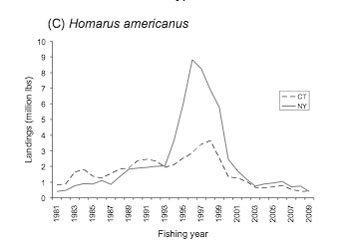WHAT’S IN STORE FOR MAINE’S LOBSTER FISHERY?
continued from January 2013 Home Page

Dr. Robert Steneck, UMaine School of Marine Sciences. Steneck and Dr. Ricahrd Whale, UM wrote, Changing conditions are likely to introduce new predators and the risk of disease as warm-water species shift northward. We must expect the unexpected, give new challenges for managing this species into the coming decades of environmental change. © Photo by Sam Murfitt
Dr. Jeffrey Shields, of the Virginia Institute of Marine Science, College of William & Mary, gave the first major presentation in which he discussed stresses to lobster caused by environmental factors, such as increased water temperature and changes in pH; human factors, such as contaminants from human activities and nutrient runoff that induces hypoxia, or reduced dissolved oxygen in the water; and diseases that require several types of agents to act in order for them to emerge.
After stating that he had heard Maine has peaked in lobster abundance Shields said, “I’ll be interested to see what happens in the next few years.” Later asked what he meant, Shields replied, “Maine’s landings have been the highest reported. Several fisheries have had large peaks in landings followed by catastrophic declines and the onset of disease. Pinpointing the problems,” he said, “is a matter of identifying the causes of declines. In most cases it’s over-fishing followed by non-recovery due to disease and other factors.”
Shields described five diseases that had been almost unknown in lobsters until they were discovered in dead lobsters from Long Island Sound and southern New England. Various things that put lobster under stress include higher than usual bottom water temperatures and hypoxia, which affects the health of lobsters in different ways. These causes were cited repeatedly during the symposium. Shields stressed the need for more studies, for further investigations, for fisheries surveys, and for “ongoing monitoring programs,” which he called “crucial to our understanding of these emerging diseases and their complex [causes.]”
Although we do not know when Maine’s lobster landings will peak— In 2011 Maine’s 5,947 fishermen landed 104,886,744 million lbs. for a value of $334,686,409. Maine Department of Marine Resources [DMR] statistician Heidi Bray, when asked if 2012’s landings would be fewer than 2011’s, replied, “No, I don’t think 2011 landings will be higher than 2012.”
After the Maine lobster fishery does peak, Shields and others wonder whether it will settle down. He said, “Landings might start 7- to 10-year cycles, as occurs in many cold-water fisheries such as snow crabs and Cancer crabs.” Speaking for himself and others, he said in conclusion, “We hope it won’t tank due to environmental and population-based stress, such as overcrowding or overfishing and disease, as happened in the red king crab fishery and the central California Dungeness crab fishery.”

Dr. Jim Wilson, UMaine. Most collapses seem to have precursors that we realize after the fact. The collapse of cod on The Grand Banks apparently was preceded a lot of indicators that seem significant after the fact. But before the collapse even if these changes were known, no one in the science establishment seemed to see them as significant. As we're learning more about the complexity of the ocean we're beginning to understand that we have to pay attention to events, to changes, at the fine scale and at the broad scale. © Photo by Sam Murfitt
Dr. Robert Steneck gave the second plenary talk, co-authored with Dr. Richard Wahle, both of the University of Maine’s School of Marine Sciences. Steneck spoke on the historical evidence of interactions between lobsters and their predators, which are mainly groundfish, such as cod. Journals of early explorers and archaeological digs in Penobscot Bay shell middens tell of thick populations of very large cod.
Despite the ecological success of the lobster as a species, its ecosystem is one of extremely low diversity, the authors state, “Prone to booms and busts in consumer populations. In the case of the American lobster, extirpating [the] few species of large-bodied predators has released past constraints on the population. Coastal Maine,” they contend, “is now virtually predator-free.”
The geographic range of the American lobster spans a very steep north-south gradient in sea temperature. The authors wrote that climate change is, “Both stressing and enhancing lobster stocks over remarkably short distances. Changing conditions,” they added, “are likely to introduce new predators and the risk of disease as warm-water species shift northward. Looking to the future,” they concluded, “we must expect the unexpected, with new challenges for managing this species into the coming decades of environmental change.”
Dr. Michael J. Fogarty, of the National Marine Fisheries Service [NMFS] is head of the Ecosystem Assessment Program at the Northeast Fisheries Science Center at Woods Hole, MA. Fogarty spoke on shifting conditions in the water in which the American lobster lives, how various forces affect it, and on eco-system-based management.
Although lobsters in the Gulf of Maine have had tremendous increases in abundance and yield in the last 30 years, they have declined dramatically in Long Island Sound [LIS] and southern New England [SNE]. Fogarty spoke of how temperature influences lobster landings and cited warming waters since 1950, which brought a spike in catches. Then temperature and catch went down in the 1960s, reaching a low point in the early 1970s. It then began a steady increase again, ultimately resulting in a crash in LIS.
But these combinations don’t work as simply as they seem. Fogarty said, “There’s a lot more we need to take into account. [Science] never predicted the sharp lobster increase in the Gulf of Maine. Factors in these changes,” he said, “included fewer large predators and environmental conditions, such as dramatic temperature increases of up to 2 degrees C. These changes, Fogarty contends, “Signal the need to consider lobster population dynamics, or forces, in a broader ecological context.”
In demonstrating shifts in distribution, Fogarty showed slides of how lobsters moved away from warmer waters and the lower chances of survival those waters create.
“It is increasingly clear,” Fogarty wrote, “that management frameworks that ignore biological interactions, environmental/climate change, and the social and economic context cannot fully capture the dimensions necessary for effective lobster management.”
He listed strong differences in temperatures and water column stratifications (the layering of the water: with colder, saltier water near the bottom and warmer, less salty water on the top).
“The implications for lobster are important,” he explained, because of the connection between the surface and bottom waters for the overall food supply near the bottom.
Fogarty spoke of “Ecosystem-based management,” and noted that a new National Ocean Policy was established in 2010 using a place-based approach with inter-relations between all eco-system components (including humans and non-humans).

Landings for lobster, Homarus americanus, from Long Island Sound (New York – solid, Connecticut – dashed) showing the non-recovery of the stock after the mortality event in western Long Island Sound in 2000, and the emergence of epizootic shell disease in eastern Long Island Sound since 2000. Data from the Long Island Sound Study.
“Surprise is the hallmark of complex adaptive systems,” Fogarty stated, adding, “Fishers are part of a complex adaptive system. The increase of lobster abundance in the Gulf of Maine over the last several decades is a good illustration of these dramatic surprise events.”
In conclusion, Fogarty noted, “The Northeast region has made progress toward implementation of ecosystem-based management with options for lobster management within an ecosystem perspective.”
Dr. Lewis Incze, of the National Science Foundation’s Biological Oceanography Program and the University of Maine’s School of Marine Sciences, gave the fourth plenary talk on connectivity, or the relationship between sources of eggs or larvae and where they settle, or recruit, to the bottom.
Although Incze acknowledged progress in understanding these patterns, he said, “We cannot assume they will follow a fixed pattern into the future because of environmental and community changes, which affect key elements of connectivity.” He also thinks, “We need to weave our understanding of connectivity into more of a holistic approach in order to support the need for BPM.” Because studies of lobster shed light on many important ecological processes, because scientists cannot afford to study each organism of potential interest, and because lobsters are economically and socially important, and researchers already know and are learning so much about them, they form, Incze said, “an excellent model organism.” He added, “We should emphasize this point more than we do.”
Although there are three ways connectivity can be studied, Incze emphasized coupled biophysical models because he feels they can address many questions and because researchers have the most experience with these types of models.
Incze discussed the types of information scientists can obtain that they have a fairly high degree of trust in, and that these approximations are useful.
He then explained “Connectivity estimates for lobsters in the Gulf of Maine, how the researchers went about getting the estimates, and the result for one year. “The resulting connectivity matrix,” he said, “describes the proportion of recruits in each Lobster Management or Analysis Zone that are derived from each ‘source’ zone where eggs are hatched and larvae first produced.
“Some zones,” Incze stated, “have high self-recruitment (a high proportion of competent postlarvae capable of settling are derived from the egg production in the same zone). Some [zones],” he said, “have low self-recruitment and depend on larvae produced elsewhere. The estimates do not claim to be 100% accurate,” he admitted, but said the relative differences between zones are something researchers can depend on.
“There are many ways,” Incze continued, “we can check on these predictions with the large volume of data that we have on settlers, postlarvae, juvenile, and adult lobsters; and everything checks out pretty well.
“One of the lessons of both studies,” he said, “is that, on average, patterns of connectivity are shorter than people have thought, based on the known potential for long-distance transport of larvae. Larvae,” he said, “indeed do get transported long distances and, in fact, most of them are lost to mortality or transport to regions where not many settle. But the longer larvae travel, the fewer there are (due to mortality) and the less there are per unit of area (due to mortality and dispersion). Because of these loss terms,” he said, “the effective (or realized) connectivity patterns are shorter than the potential patterns.
“We now know enough to suggest patterns of connectivity in the two studied areas” [of the Gulf of Maine and Northumberland Strait],” Incze said in conclusion. He then made four recommendations:
1. To use existing types of models to evaluate scenarios such as changing patterns of egg production
2. To improve understanding of small-scale exchanges, such as between coastal currents and coastal embayments
3. To work with climate modelers to establish a better understanding of how climate change might affect the ecosystem at meaningful scales (e.g. within the Gulf of Maine)
4. Early Life Stage [ELS] characteristics are always interesting,” he said, adding that researchers need to be strategic about questions so those they ask help address major needs rather than minor curiosities.
University of Maine economist James Wilson pulled together questions discussed and summed up the point of the symposium as moderator of a discussion group entitled “Human-Natural Systems & EcoSystem-Based Management” Thursday afternoon and as part of general roundtable discussion and meeting recap the morning of the third and final day of the symposium.
Retired geologist and environmental consultant Andrew Stancioff, of Spruce Head, corroborated the opinions of many when he said, “My thought is that the importance of the meeting was demonstrated at the closing sessions, at which it became clear that we have little influence on global warming and the possibility of the disappearance of the lobster. Rather,” he stated, “our influence and our work should focus on human development and a rational approach to fishing, the environment, and economic development.”
To those points, Wilson said of lobster population collapses, “There is a popular notion that seems to be shared by many scientists that [such] events just happen overnight. I don’t think that is true.” He said, “It only seems true when one (or science) only looks at [a single] scale, e.g., total population abundance. Most collapses seem to have precursors that we realize after the fact.” He gave as an example the cod fishery.
“The collapse of cod on The Grand Banks apparently was preceded by the loss of inshore populations, the spatial concentration of fish on the banks, changes in movements -- a lot of indicators that seem significant after the fact. But before the collapse,” Wilson said, “Even if these changes were known, no one in the science establishment seemed to see them as significant.” He went on to note that standard fisheries theory has nothing to say about the meanings of these kinds of events. “As we’re learning more about the complexity of the ocean,” Wilson said, “We’re beginning to understand that we have to pay attention to events, to changes, at the fine scale and at the broad scale.
“The problem with collapses,” he observed, “is that it is hard to determine their causes beforehand. When there are lots of people with different perspectives watching the fishery and talking with one another, they stand a good chance of putting together a consensus about what is happening. When one person or one group is looking at only one aspect of the fishery, the likelihood of spotting a significant change before it happens is close to nil.”
Wilson recommended finding ways to observe what’s happening to the water in Maine’s bays as its marine scientists have been doing for the past 15 years, as well as learning currents and temperatures. In addition to continuing to monitor lobster settlement, as Wahle has been doing, Wilson suggested monitoring all the pre-recruit populations. This, he said, “Probably means monitoring lobster health, trap mortality, etc.” Although Wilson said he couldn’t attempt to name all the things Maine’s lobster scientists should be looking at, he did say there is a lot the industry can and should do. Then, he said, “Someone, [either] DMR or Sea Grant has to find the way to convene the discussion about what is happening.”
Without question, attendees agreed Wilson’s suggestions need to be implemented soon and with the help of fishermen. With 2012’s landings expected to exceed 2011’s almost 105 million lbs., Wilson, in speaking of these almost inconceivable numbers, asked rhetorically, “How long can we ride this wave of abundance?”
